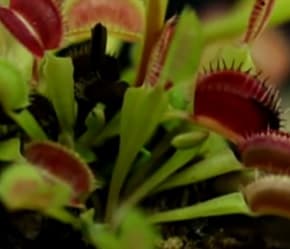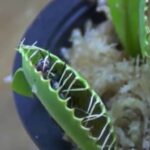As an Amazon Associate, this site earns commissions from qualifying purchases. For more details, click here.
The Internet is full of advice on what food to give Venus flytraps, but should you even do it? There are several misconceptions about feeding Venus flytraps and this creates a lot of confusion. So here are the facts.
If your Venus flytrap is outdoors, do not feed it. The plant will lure insects by itself. If raising Venus flytraps indoors, feed it every every two weeks. Do not give human food to these plants.
Why You Should Not Feed Outdoor Venus Flytraps
Venus flytraps have survived without being hand fed by humans for a long time. If you are cultivating the plant outdoors, it is more than capable of luring prey.
You can tell the plant is eating because one or more traps are closed. In fact, Venus flytraps are so good at attracting insects that I always see at least one trap closed.
But how do Venus flytraps do this? Their traps capture and digest insects, but why are bugs drawn to the plant?
The leaves of a Venus flytrap secrete a fruity smell which attracts bugs. When a fly for instance, drops onto its leaves, the trap is set.
As you can see, Venus flytraps are very capable of feeding themselves. After the plant has eaten, the trap reopens.
Related. How long do Venus flytraps stay closed?
How to Feed Indoor Venus Flytraps
Indoor Venus flytraps can be fed every two weeks. Most of them will survive with just one bug a month, but twice monthly feeding encourages growth.
Outdoors, Venus flytraps use their scent to attract prey. Unless you leave the doors and windows open, an indoor Venus flytrap won’t catch anything.
This is where you come in. So without further ado, let’s take a look at how and what to feed indoor Venus flytraps.
What to Feed Indoor Venus Flytraps
Live insects like spiders, grasshoppers, flies, spiders, ants and crickets are part of their diet. Venus flytraps also eat mealworms, bloodworms, dead bugs, fish flakes and Ultra Fresh betta fish pellets.
Live insects. Venus flytraps feed on live bugs in the wild, so this is the best choice. Feeding live insects can be a challenge though, but there are other options.
Dead bugs. You can buy freeze dried insects such as Hatortempt and give them to your Venus flytrap. You only have to feed one or two traps at the same time.
Cut the food so it is one third the size of the trap. Place the bug in the trap. Prod the hair triggers with tweezers so it closes.
It’s more convenient to feed dead bugs to a Venus flytrap than a live one. If you’re a beginner, coaxing the trap to close might seem like a challenge, but it’s easy.
Mealworms, bloodworms and fish food. Yes, Venus flytraps eat them and there are no side effects. They are just as nutritious for these plants as bugs and also widely available.
My choice for freeze dried bloodworms is BNYEE. When I want to mix things up I grab some fish pellets or Tetra fish flakes instead.
Feeding mealworms or fish food to Venus flytraps is straightforward. Take a small amount (no more than one third the size of the trap you are going to feed) and place it on the trap. Prod the trap with a brush or tweezers until it closes.

Never Give Venus Flytraps These Foods
Any food for humans is not fit for Venus flytraps. Beef, hotdogs, cheese, donuts, cakes, pizza etc. are a no-no. Venus flytraps cannot eat fruits or vegetables either.
You have probably seen videos of Venus flytraps being fed ice cream, chocolate and all kinds of food. It might seem like harmless fun, but it can be a health hazard.
If you stimulate the trap and leave a piece of fruit in it, the trap will close. Either of the following is going to happen.
If the trap doesn’t eat the fruit, it is going to rot and infect the trap and kill it.
if the trap tries to eat the fruit, it will die too because Venus flytraps cannot digest it.
If you don’t remove the rotting fruit, the infection might spread to the rest of the plant. I used fruit as an example but it also applies to meat and other human food.
Can I Feed Venus Flytraps Every Day?
No you should not. Unlike humans, Venus flytraps do not have to eat every day. In fact, daily feeding will cause more harm than good. Feeding every two weeks is enough.
Venus flytraps set aside a lot of resources to trap and digest prey. It is a complex process which involves counting and memory LNK. While the plant loses energy, it gains nutrients from its prey. From a risk-reward standpoint it’s worth it.
If you feed Venus flytraps every day, the plant will lose energy faster and won’t have enough resources left for digestion.
Venus flytraps take 1-2 weeks to eat food. This process uses up energy but it gets replenished by the nutrients it is absorbing.
If you give food to the other traps, the plant will not have enough energy to consume it. The trap will open if you stimulate it but it won’t be able to digest the food. The trap will try anyway and eventually it’s going to blacken, die and fall off.
Bottom line: overeating is bad for Venus flytraps. Remember, the food should be one third the trap size, and feed every two weeks.. That’s all the plant needs.
Will Venus Flytraps Die without Food?
Venus flytraps will not die if they don’t eat bugs. But bugs are not really food for these plants.
Strictly speaking, Venus flytraps do not “eat”, not the way that humans and animals do. The word “eat” is used for simplicity, though “absorbing nutrients” is probably more accurate.
Carnivorous plants like Venus flytraps only grow in poor soil. They consume insects because they have the nutrients which is lacking in the ground.
The closest thing to food for Venus flytraps is glucose, which it produces through photosynthesis. Without glucose, the plant cannot survive.
So to answer the question if Venus flytraps can survive without food, it depends.
If by food we mean bugs, then yes, Venus flytraps can live without them. The plant will not grow much but it will live provided there is enough light and water.
If by food we refer to glucose, then no. Venus flytraps require glucose to live.
Why Venus Flytrap Leaves Turn Black After Eating
This looks alarming but there are many possible reasons why this happens. In most cases it is nothing to worry about.
Age. A trap can only eat a few bugs before it dies. Sometimes the trap blackens and dies after consuming a large meal.
After the trap dies and falls off, a new one will grow in its place. It is normal and part of the plant’s life cycle.
Wrong food. A trap can blacken if given the wrong food. This can also happen if the prey is too large.
Sometimes large bugs walk into the trap, causing it to snap shut. Usually the bug just tears up the leaf but in some cases, it is unable to escape.
The bug suffocates but because of its size, only partially digested. Decay sets in, killing the trap. This happens with a lot of Venus flytraps and is not a cause for concern.
Poor environment. If the traps always turn black after eating, the plant is stressed.
Is there enough light? Venus flytraps need at least 6 hours a day for optimum growth. The plant prefers moist soil and humidity at 50% or higher.
If you just bought a Venus flytrap LNK, it might still be adjusting to its new home. Give the plant a couple of weeks to settle in and its traps should be fine.
Dormancy. A dormant Venus flytrap will not eat. Simply wait for the plant to come out of dormancy after 3-4 months.

My fascination with carnivorous plants began many, many years ago with Venus Fly Traps. Now I am more than happy to impart what I know with other enthusiasts and those who are curious about meat eating plants.


